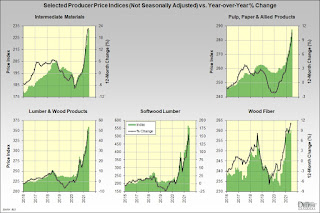Sales of new
single-family houses in June 2021 were at a seasonally adjusted annual rate (SAAR)
of 676,000 units (800,000 expected).
This is 6.6% (±16.5%)* below the revised May rate of 724,000 (originally 769,000
units) and 19.4% (±13.9%) below the June 2020 SAAR of 839,000 units; the
not-seasonally adjusted (NSA) year-over-year comparison (shown in the table
above) was -24.1%. For longer-term perspectives, NSA sales were 51.3% below the
“housing bubble” peak but 14.8% above the long-term, pre-2000 average.
The
median sales price of new houses sold in June fell ($18,900 or -5.0% MoM) to $361,800;
meanwhile, the average sales price slid to $428,700 ($5,300 or -1.2% MoM). Starter
homes (defined here as those priced below $200,000) comprised 2.3% of the total
sold, down from the year-earlier 7.6%; prior to the Great Recession starter
homes represented as much as 61% of total new-home sales. Homes priced below
$150,000 were less than 0.7% of sales, down from 1.3% a year earlier.
* 90% confidence interval includes zero. The Census Bureau does not have sufficient statistical evidence to conclude that the actual change is different from zero.
As mentioned in our post about housing permits, starts and completions in June, single-unit completions fell by 59,000 units (-6.1%). Although sales fell by a smaller amount (48,000 units; -6.6%), inventory for sale rose in absolute (+20,000 units) and months-of-inventory (+0.8 month) terms.
Existing home sales edged higher in June (80,000 units or +1.4%), to a SAAR of 5.86 million units (5.900 million expected). Inventory of existing homes for sale expanded in absolute (40,000 units) and months-of-inventory (0.1 month) terms. Because resales rose while new-home sales fell, the share of total sales comprised of new homes dropped to 10.3%. The median price of previously owned homes sold in June advanced to a record $363,300 ($12,900 or +3.7% MoM).
Housing
affordability dipped by 4.1 percentage points as the median price of
existing homes for sale in May rose by $10,400 (+3.0% MoM; +24.4 YoY), to $346,200.
Concurrently, Standard
& Poor’s reported that the U.S. National Index in the S&P Case-Shiller
CoreLogic Home Price indices rose at a not-seasonally adjusted monthly change
of +2.1% (+16.6% YoY).
“Housing
price growth set a record for the second consecutive month in May 2021,” said
Craig Lazzara, Managing Director and Global Head of Index Investment Strategy
at S&P DJI. “The National Composite Index marked its twelfth consecutive
month of accelerating prices with a 16.6% gain from year-ago levels, up from
14.8% in April. This acceleration is also reflected in the 10- and 20-City
Composites (up 16.4% and 17.0%, respectively). The market’s strength continues
to be broadly-based: all 20 cities rose, and all 20 gained more in the 12
months ended in May than they had gained in the 12 months ended in April.
Prices in 18 of our 20 cities now stand at all-time highs, as do the National
Composite and both the 10- and 20-City indices.
“A
month ago, I described April’s performance as 'truly extraordinary,' and this
month I find myself running out of superlatives. The 16.6% gain is the highest
reading in more than 30 years of S&P CoreLogic Case-Shiller data. As was
the case last month, five cities -- Charlotte, Cleveland, Dallas, Denver, and
Seattle -- joined the National Composite in recording their all-time highest
12-month gains. Price gains in all 20 cities were in the top quartile of
historical performance; in 17 cities, price gains were in top decile.
“We
have previously suggested that the strength in the U.S. housing market is being
driven in part by reaction to the COVID pandemic, as potential buyers move from
urban apartments to suburban homes. May’s data continue to be consistent with
this hypothesis. This demand surge may simply represent an acceleration of
purchases that would have occurred anyway over the next several years.
Alternatively, there may have been a secular change in locational preferences,
leading to a permanent shift in the demand curve for housing. More time and
data will be required to analyze this question.
“Phoenix’s 25.9% increase led all cities for the 24th consecutive month, with San Diego (+24.7%) and Seattle (+23.4%) close behind. As was the case last month, prices were strongest in the West (+19.9%) and Southwest (+19.8%), but every region logged double-digit gains.”
The foregoing comments represent the general economic views and analysis of Delphi Advisors, and are provided solely for the purpose of information, instruction and discourse. They do not constitute a solicitation or recommendation regarding any investment.






















































